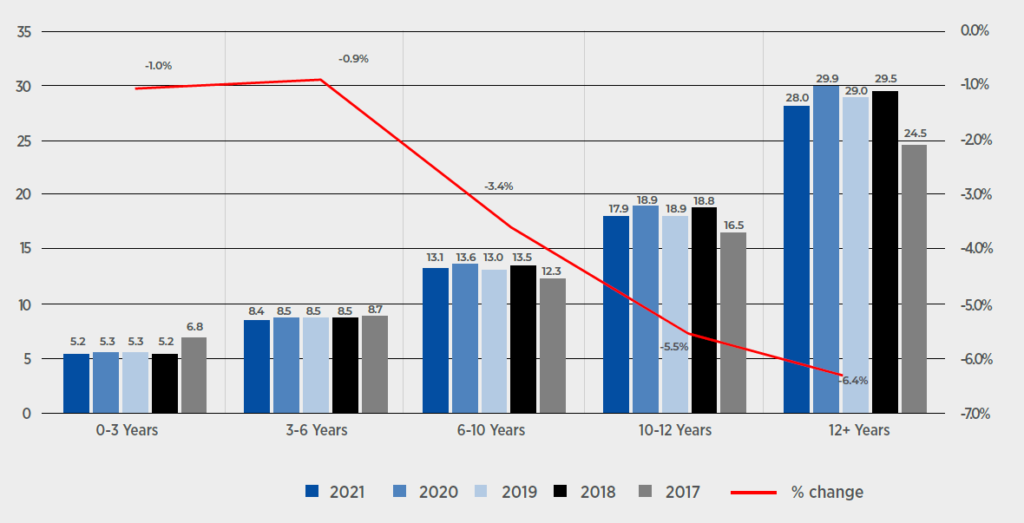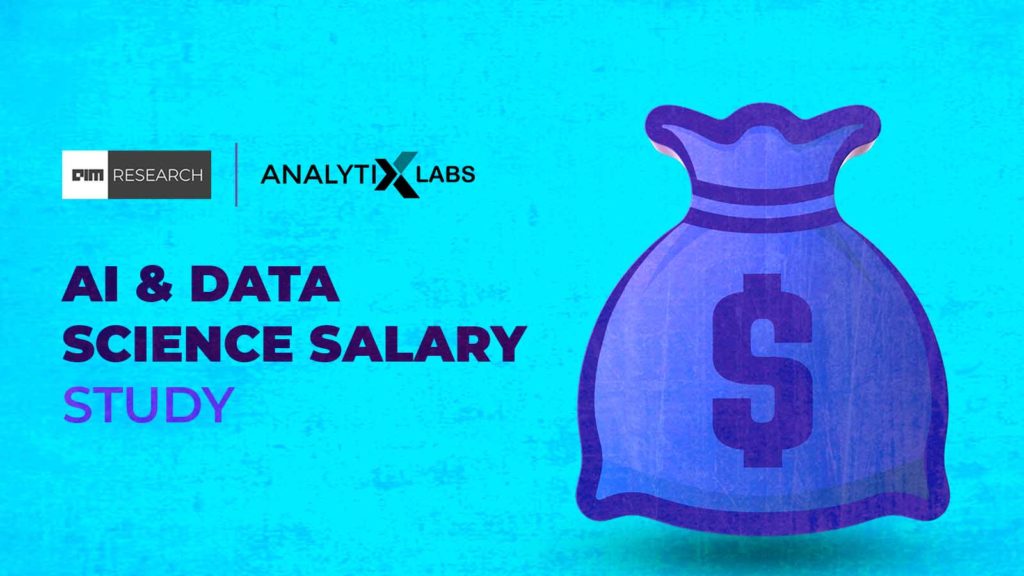The annual Analytics India Salary report presented by AIM and AnalytixLabs is the only annual study in India that delves into salary trends and provides a comprehensive view of the changing landscape of analytics salaries. The report, now in its seventh year, look at the distribution of average salaries across several categories including years of experience, metropolitan regions, industries, education levels, gender, tools, and skills.
The Data Analytics function is experiencing significant growth and development in terms of skills, capabilities, and funding. Last year, despite the pandemic, the Indian start-up industry witnessed $836.3 million investment, almost a 10% (9.7%) increase than the previous year. Also, more than one in five (21%) analytics teams across firms in India witnessed a growth in the last 12 months and the post-pandemic job market saw an upswing of data science jobs. The development of the data science domain is evidenced by the high salaries drawn by analytics professionals across the organization, with Analytics professionals doing relatively well in spite of the pandemic.
The scale of growth of any domain is evinced by the salaries drawn by experienced professionals or the growth in the proportion of experienced professionals drawing higher salaries. This past year has indeed been an effective growth year for the Data Science and Analytics domain, with an increase in the median salary in the analytics function and a corresponding increase in salaries and the proportion of professionals in the upper experience cadre.
To know more about our research services, visit AIMResearch
Read reports from previous years.
2020 | 2019 | 2018 | 2017 | 2016 | 2015
Key Highlights
- The median salary of analytics professionals in India in 2021 is INR 13.4 Lakhs – a 6.9% decline over the 2020 median salary of INR 14.4 Lakhs. Much of the decrease in salary can be attributed to the pandemic. In spite of this, the median has remained above the 2019 median.
- The proportion of the analytics professionals remains the highest in the entry and middle-income levels (0-6 Lakhs – 38.2% and 6-10 Lakhs – 20.3%). The salary cuts led to an increase in the percentage of Analytics professionals in lower brackets.
- However, 41.5% of all the analytics professionals fall under the higher income level (greater than 10 Lakhs per annum). The percentage of analytics professionals with greater than 10 lakh salary was 45.6% in 2020, signifying a decrease in the percentage of professionals in the bracket
SECTION 1: SALARY DISTRIBUTION ACROSS VARIOUS BRACKETS
This section covers the findings of the proportion size and median salaries of analytics professionals across experience and salary levels. While the median salary of all analytics professionals is 13.4 Lakhs, the greatest proportion of analytics professionals fall under the 0-6 Lakhs category at 38.2%. This is followed by the 6-10 Lakhs salary level that has 20.3% of the analytics professionals.
However, 41.5% of all the analytics professionals fall under the higher income level, greater than 10 Lakhs. The salary levels of 10-15, 15-25, 25- 50 Lakhs have significant proportions of 16%, 14.5%, and 7.8% respectively. The proportions for these levels have fallen from the corresponding 2020 percentages of 17%, 16.2%, and 8.5%, highlighting the temporary shift induced by the pandemic.
SECTION 2: SALARIES IN ANALYTICS COMPARED TO OTHER IT ROLES
The impact of any function or role within a broader domain is highlighted after comparing the salaries of that function with those of the broader domain. with those of the broader domain. For the Analytics function, the salaries earned by professionals are the highest vis-à-vis the salaries for other roles – underscoring the impact of analytics roles across organizations.
The median salary for analytics professionals, at Rs. 13.4 Lakhs is 4% higher than the salaries for the next highest salary of Cloud Developer professionals. Similarly, the salary for an Analytics professional is 44% higher than that of a Software Engineer, and 36% and 50% higher than the salaries of an IT Developer and a Java Developer respectively.
SECTION 3: SALARY TRENDS ACROSS CITIES
Once again, Mumbai emerges as the destination for the highest salaries for analytics employees at 14.7 Lakhs per annum as median salary, followed by Bengaluru at 14.5 Lakhs.
- The higher cost of living in Mumbai has pushed the salaries of analytics professionals to the highest level as compared to other cities.
- Apart from that, it is a very sector-niche location as the majority of Domestic Banks (ICICI and HDFC Bank), Consulting Firms, MNC Banks, and Investment firms (Nomura), have their head offices, financial and investment centres, and analytics operations based out of Mumbai.
- Mumbai also saw the biggest decrease in analytics salaries in the last 12 months, at 5.7% whereas Bengaluru saw the lowest decrease in salaries, at just 1.2%.
- Bangalore is a host to most of the industry startups or in the case of Ola or PhonePe have their management or analytics based out of Bengaluru. Along with the startups, some of the top MNCs captive centres like Accenture, Oracle, Dell and the presence of top domestic IT firms headquartered in TCS, Infosys, and Wipro has made Bangalore the city with the second-highest median salary for Analytics Professionals.
- Similarly, the BPO/KPO hub of Delhi NCR registers the median salaries for analytics personnel at 3rd place at 13.0 Lakhs
- Pune and Hyderabad are placed 4th and 5th in terms of salaries at 11.8 Lakhs and 11.6 Lakhs respectively.
- The salaries of analytics professionals in Chennai is the lowest (among large cities) at INR 11.0 Lakhs
SECTION 4: SALARIES ACROSS EXPERIENCE LEVELS
Comparing the median salary across experience levels, the salaries of Analytics professionals at higher positions have been impacted more than the others due to the pandemic. This could be because of an uneven percentage of salary cuts across a company, with salaries of Analytics professionals in senior roles receiving the brunt more than the junior roles.
With domestic and international enterprises setting up dedicated analytics functions, the number of senior-level employment across organizations has risen. Almost one in six (16.2%) of Analytics employees across companies have more than 12 years of experience. This is indicative of companies hiring senior professionals to gain insights and intelligence on consumers, markets, and the next growth products.
The median salary of Analytics professionals with 3 to 6 years of experience decreased by a negligible 0.9% and stands at 8.4 Lakhs per annum. The median salaries of professionals with experience greater than 12 years are the highest across all experience levels, at 28 lakhs/ annum. This is a decrease from last year’s salary of 29.9 Lakhs, a drop of almost 6.4%. Similarly, the salaries for the experience levels of 10-12 years and 6-10 years also recorded a decrease over the last year and stand at 17.9 Lakhs (5.5% drop) and 13.1 Lakhs (3.4% drop) respectively, highlighting a pandemic induced decrease in salaries.

SECTION 5: SALARIES ACROSS INDUSTRIES
This year, the most important factor to decide salaries across sectors was the pandemic. The impact of the pandemic, and the resulting lockdown restrictions, was felt unequally by different industries. Some sectors like manufacturing had to halt their functions entirely, whereas the importance of sectors like e-commerce increased drastically.
- Analytics professionals in the Telecom sector, as they did last year, have the highest median salaries across all sectors at 17.9 Lakhs. The telecom sector also saw a drop of almost 10% in salaries since last year’s salaries of 19.8 lakhs.
- The professionals in the Energy/ Industrials sector command a salary of Rs. 15 Lakhs. This sector saw the biggest drop in salaries, of 18%, since last year at 18.2 Lakhs. The Energy/Industrials sector now lags the CPG/Retail in terms of median salaries for analytics professionals.
- CPG/Retail sector salaries remained the same as last year at 17.6 Lakhs per annum.
- The Media & Entertainment and e-commerce sectors figure lower in rank in terms of employees’ salaries at 13.3 and 12.6 Lakhs respectively. The employees in these 2 sectors have seen a drop in salaries over last year – 3% and 5% respectively.
- The employees in the Travel and Hospitality sector have the lowest median salary at 11.9 Lakhs, with a drop of almost 7%.
- The Banking sector is one of the earliest adopters of analytics in India. Moreover, after the IT companies, banking organizations are the largest recruiters of analytics professionals in India. The median salary for Banking for analytics professionals currently is at the middle of the spread at 14.6 Lakhs, a drop of 7%.
- The CPG/Retail has the highest number of professionals (6.2%) in the upper salary bracket of 50 Lakh and above. This is followed by the Telecom sector that has 5.5% of its professionals in the bracket of salaries greater than 50 Lakhs.
- Finally, the largest proportion of entry-level analytics professionals are employed in the Travel/Hospitality sector at 45%, commanding salaries less than 6 Lakhs per annum.
- All the sectors saw a decrease in salaries in the last 1 year, with Energy/Industrials witnessing the largest drop of 18%.
SECTION 6: SALARIES ACROSS DATA SCIENCE ROLES
This year the Data Engineers and the Big Data Specialists surpassed the median salary of AI Engineers by a narrow margin. The median salary for these roles in 2021 is at 14.9 and 14.8 lakhs per annum indicating an increase of 2.3% and 3.0% respectively from last year. The AI Engineers’ median salary stands at 14.6 Lakhs per annum. This median indicates a 7.3% decrease as compared to 2020 (when it was 15.7 Lakhs). The median salaries for reporting and MIS professionals are the lowest and the same as last year at 8.6 Lakhs per annum.
SECTION 7: SALARIES BY COMPANY TYPES
In this section, the types of companies have been classified on the basis of the core operations (captive, domestic firms, IT service providers) of the organizations.
The salaries of analytics personnel within Captive Centres are at the highest band of all median salaries at 16.9 Lakhs. However, this showed a drop of 10.0% as compared to the 2020 median.
Consulting firms have large analytics operations – they provide analytics services either as a standalone function or as part of the entire consulting package. Within the entire package, they leverage analytics to draw inferences and recommendations for their clients. These two services are provided for both global and domestic clients from their India operation centres. Consulting firms thus offer the second-highest salaries at 16.2 Lakhs, which is the same as last year.
The Boutique Analytics firms are small to medium-sized service providers with a niche focus on analytics and related fields. Boutique Analytics firms saw an increase of 7.6% and jumped ahead of Domestic Firms as compared to the last year. In 2021, the Boutique Analytics firms are paying a median salary of 13.9 lakh per annum as compared to the 13.4 lakh of 2020.
While domestic firms like Reliance, Godrej, and Aditya Birla have set up exclusive analytics units, Data Science and Analytics might have taken a back seat during the pandemic. Similar is the case with big IT firms, like Wipro, Infosys, and TCS, who provide Analytics services to other companies as a part of their value chain. Both types of firms saw a huge decline in their median salary. The IT services companies dropped the median salary of Analytics Professionals by the highest margin at 13.3% in 2021. The 2021 median salary stands at 10.4 lakh per annum as compared to 12.1 lakhs last year.
SECTION 8: SALARIES BY EDUCATION QUALIFICATIONS
Not only does engineering or a management degree help you hike your salary it also matters which institute the masters/ bachelors is from as well. The chances of a higher salary are greater by a significant margin when your bachelors/masters is from a top-tier institute like the IIT, IISc, or the IIM.
Engineering undergraduates from top-tier institutions, like last year, have the highest median salaries at 24.2 lakh per annum, which is almost the same as last year. On the flip side, an employee with an engineering undergraduate degree from the wider pool of institutions earns a salary of 13.2 Lakhs. Hence, an engineering degree from a top-tier, premier institute, can earn employees 83.8% more than those employees from the wider engineering undergraduate.
Management post-graduates from top-tier institutes draw the second-highest median salary of 24.1 Lakhs in 2021. This was a 1.9% rise from last year. An employee from the wider pool of MBA institutions can command a salary of 15.6 Lakhs Hence, a management degree from a top-tier, premier institute, can earn employees 55.2% more than those employees from the wider MBA graduate.
While engineering and management graduates from top-tier institutes have a negligible difference in their median salary, the gap between the two graduates for other institutes is 18.0%. The PhD graduates saw a significant decline of 5.5% in their median salaries as it dropped from 22.6 lakh per annum to 21.3 lakh per annum The non-engineering undergraduates or non-MBA post-graduates earn the least at 12.5 and 12.0 lakh per annum respectively.
SECTION 9: GENDER SALARY GAP
While the analytics function has seen significant overall growth in terms of salaries and capabilities, the salary disparity between women and men employees still exists. While the pandemic did not increase the gender pay gap in the Analytics industry like it did otherwise, the gap has remained almost the same in the past few years. This gap is attributed to low female representation, highlighted in our Women in AI report. This exists because of the association of analytics, and the broader science and technology functions with men, while women are associated more with functions related to social sciences and arts.
Men command a median salary of 14.6 Lakhs, while women command a median salary of 10.1 Lakhs. The median salary of women is thus 45% lower than the median salary of men and is 25% lower than the overall median salary of 13.4 Lakhs.
This year, the median salary gap between the salaries of men and women has marginally reduced to 45% from last year’s large gap of 47%. Overall, the salaries of men reduced by 7.2% in the last 1 year. Compared to this, the salaries of women decreased by 5.9%.
SECTION 10: SALARIES BY TOOLS
Analytics professionals with Python as a primary skill set saw their salaries rise from 15.3 to 15.8 lakhs in 2021, a rise of 4% Python is currently the highest required “tool” skill set in analytics. Hadoop saw the highest decline in median salary at 15%. In 2021, the median salary for professionals specialising in Hadoop stands at 12.0 Lakhs per annum as compared to 14.1 Lakhs from last year.
CONCLUSION
While the Analytics industry continues to grow, it was no exception to the pandemic. Firms had to resort to budget cuts impacting Analytics professionals’ salaries. The median salary of Analytics professionals in India stands at 13.4 Lakhs per annum in 2021, which indicated an 8.3% decline as compared to 2020 when it was at 14.4 Lakhs. However, this did not spell all doom and gloom as, in spite of the pandemic, the industry was able to maintain the median above 2019.
The budget cuts resulted in the redistribution of salary brackets as the share of Analytics professionals in lower brackets increased. The percentage of Analytics professionals with lower salary brackets in the 0-6 Lakh per annum increased by 4.9 percentage points. On the other hand, the percentage of analytics professionals with greater than 10 lakh salary was 41.5% in 2021, indicating a decrease of 4.1 percentage points from 2020.
In conclusion, fresh graduates considering a career in IT, and experienced IT or domain professionals considering a career shift should consider a career in the analytics domain and upskilling to an analytics capability respectively. Such professionals could look at the sectors or companies that have digitised more after the pandemic and focus on improving their skills beyond Python to develop specific expertise that is more in demand.
There is ample opportunity for growth, in terms of learning, capability, and compensation in the analytics function – analytics professionals commanded the highest salary across all IT functions.
DOWNLOAD THE COMPLETE REPORT
To know more about our research services, visit AIMResearch


























